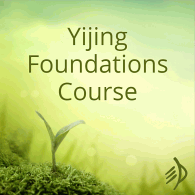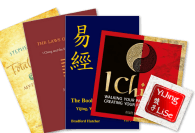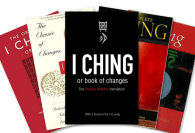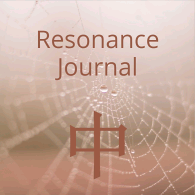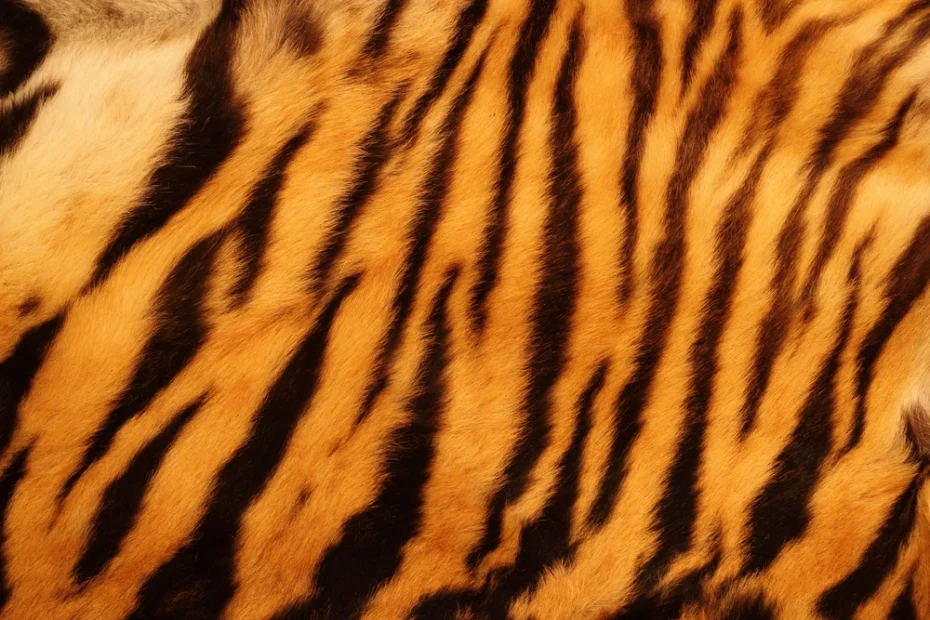Chinese tigers
Tigers have been prowling through Chinese thought and folklore for many thousands of years. Their meaning is interesting: not just wildness and danger, though of course they might eat you, but also courage and protection against evil – from the wild boar that would eat your crops, and also from demons and evil spirits. Lindqvist writes,
‘There are a great many tales about tigers, or rather tigresses, saving people from evil forces and giving their milk to abandoned infants, much like the story of Romulus and Remus and the she-wolf of Rome.’
Small children wore caps or shoes depicting tigers for protection; warriors had tigers on their shields. They also adopted tiger shields and skins to share in the tiger’s power and ferocity: ‘tiger’ was a term of respect for military leaders. And there is the mysterious motif of Chinese bronzes, showing a human figure, quite peaceful, in the tiger’s mouth. As far as I’m aware, no-one knows what these represent. The best guess is that they have shamanic significance – passing through the tiger’s mouth into a new realm.
Yijing tigers
The tiger appears in three places in the Yijing. First in Hexagram 10 –
‘Treading a tiger’s tail.
It does not bite people.
Creating success.’
and also in its third and fourth lines:
‘With one eye, can see.
Lame, can still walk.
Treads on the tiger’s tail:
It bites him. Pitfall.
Soldier acting as a great leader.’
‘Treading the tiger’s tail.
Pleading, pleading,
Good fortune in the end.’
Then towards the centre of the whole book, in Hexagram 27, line 4:
‘Unbalanced nourishment,
Good fortune.
Tiger watches, glares and glares.
Chases and chases his desires.
No mistake.’
And finally, triumphantly, in the fifth line of Hexagram 49, Radical Change:
‘Great person transforms like a tiger.
Even before the augury, there is truth and confidence.’
Introducing the tiger: Hexagram 10
The oldest representation of a Chinese tiger is in a burial, where the body is flanked by figures outlined in shells: a dragon to the east, a tiger to the west.
This is at least 5,000 years old – and the positions of dragon and tiger to east and west are those known to feng shui tradition. Tigers are the counterpart of dragons, part of the binary of earth and heaven, female and male, that eventually became yin and yang.
The Yi begins with the flight of the dragon through Hexagram 1. Then Hexagram 2 (where the dragons also show up in line 6) says,
‘Fruitful in the south and west, gaining partners.
In the east and north, losing partners.’
Each point of the compass has its corresponding trigram in the Later Heaven Bagua (which, confusingly, is the oldest arrangement):
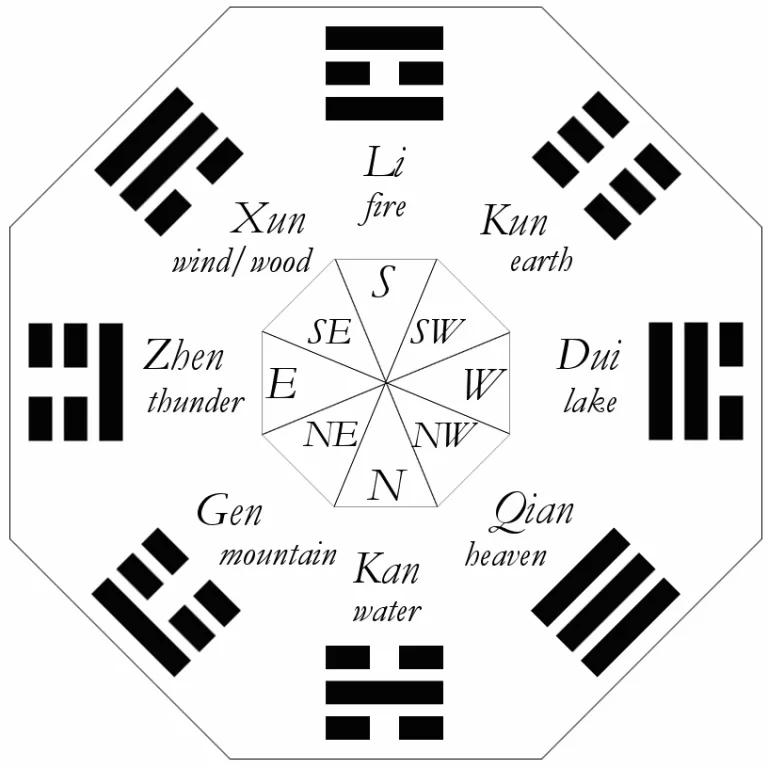
The east and north, where you lose partners, are zhen and kan, the constituent trigrams of the very next hexagram, 3, Sprouting. The south is li, fire, which appears for the first time in Hexagram 13, People in Harmony – gaining partners! And west is dui, lake, which appears for the first time in Hexagram 10.
So the tiger appears in the west, just as it did in the Neolithic burial. It stands opposite the dragon of Hexagram 1, just as it has always done, and we have travelled all the way across from Hexagram 3 to reach it. And… could we gain it as a partner?
‘Treading a tiger’s tail.
It does not bite people.
Creating success.’
You know I like to ask the most simple-minded questions I can come up with about hexagrams and readings (and I can come up with some really simple minded ones!). For instance, why would anyone want to tread on, or near, a tiger’s tail? If it bites, you’re cat food. Wouldn’t it make a lot more sense to go quickly and quietly in the opposite direction?
The combination of those tiger associations – courage, protection, balance for dragon-powers – with reading experience helps to answer the question. People want to get closer to the tiger so they can share in its power and vitality. I’ve seen this refer to experiences from asking the boss for a raise to visiting a sacred place full of spiritual power. It’s about connecting with power, not just as pure idea or inspiration, but here in the real world. So we dance with something that might swallow us whole; we need to Tread with care, to observe the correct rituals –
‘Things are tamed, and then there are the rituals. And so Treading follows.’
Sometimes, too, Hexagram 10 can simply be a warning that there is a tiger much closer than you thought: a big, fierce spirit, something you really shouldn’t tread on by mistake.
That comes through especially in the two moving lines with the tiger – lines 3 and 4, what’s known as the ‘human position’ in a hexagram – its awkward centre, where we try to bridge the gulf between heaven and earth, ideal and implementation, and don’t always manage it. Changing together, these two lines look back to paired hexagram 9, Small Tending. That’s a time for careful, small-scale cultivation, preparing the ground, becoming ready to receive the Mandate of Heaven, but not ready yet.
Treading’s Small Tending:
‘With one eye, can see.
Lame, can still walk.
Treads on the tiger’s tail:
It bites him. Pitfall.
Soldier acting as a great leader.’
‘Treading the tiger’s tail.
Pleading, pleading,
Good fortune in the end.’
Both lines need to be careful: the very first thing to know about the tiger is that this could eat you. It looks like there are two ways this could go: will you be bitten, or blessed? The difference between the two has a lot to do with their zhi gua, the hexagram each line changes to.
Line 3 is not up to the tiger’s challenge, though it imagines differently. The ‘small image’ commentary on the line says,
‘”The one-eyed may still see” but not well enough to achieve clarity. “The lame may still tread” but not well enough to keep up. The misfortune of being bitten here is due to one’s being unsuited for the position involved. “A warrior tries to pass himself off as a great sovereign” because his will knows nothing but hardness and strength.’
(R.J. Lynn’s translation)
This line changes to Hexagram 1 – it has altogether too much dragon energy. It’s full of beautiful ideas, but lacks the capacity to live with them, embody them, in practice, and is about to get a nasty reality check.
Line 4 is just beginning to create a better relationship with the tiger, ‘pleading and pleading’, and this could be the beginning of good fortune (which is coming ‘in the end’, not right away). There is a powerful, fierce spirit here – maybe protective, certainly not rational. Sometimes it’s someone else’s, sometimes it belongs to the questioner; either way, it needs approaching with extreme care, and with complete presence of mind.
That presence of mind is found in the relating hexagram for the line: 61, Inner Truth. ‘Pleading, pleading’ is the voice of inner truth: present, wholly connected between heaven and earth, trusting, vulnerable.
Through the tiger’s mouth: Hexagram 27
The tiger’s next appearance – and the one that’s most powerfully reminiscent of those mysterious bronzes – is in the fourth line of Hexagram 27, Nourishment or Jaws:
‘Unbalanced nourishment,
Good fortune.
Tiger watches, glares and glares.
Chases and chases its desires.
No mistake.’
This line changes to Hexagram 21. Who could be better at Biting Through than the tiger? Scott Davis looked back to the fan yao, 21.4 changing to 27, and suggested the ‘dried bony meat’ of that line is being fed to the tiger, swallowed by the Jaws. For him, this is part of the transformation of boy to young man, passing through the tiger’s mouth in initiation.
Also, the line change here creates the trigram li, which represents fire, light and vision, for the tiger ‘watching, glaring, glaring’.
This is nourishment that’s ‘unbalanced’ – toppling over, overthrown. It seems quite odd that this should mean ‘good fortune’: isn’t balance and harmony the goal? But the tiger is not looking for balance; it’s ‘chasing, chasing its desires’. The components of this Chinese word 逐 zhu, chasing, show a foot on the road after a pig – the tiger’s desires aren’t ambiguous or complicated.
The glaring, chasing tiger means good fortune, not something we should stop, second-guess or try to moderate. The hunger of Hexagram 27 joins with the resolve of Hexagram 21: know what you want, go after what you need, bite through the obstacles. There’s more to life than balance.
You can see that a transformation is underway here, compared with the propitiatory caution of Hexagram 10. The natural way to respond to this line, I’ve always found, is to start to identify with the tiger, experience the intensity of your own desires and be less afraid of them. Good fortune; no mistake.
Becoming the tiger: Hexagram 49
The tiger’s appeared at a third line (bad news) and two fourth lines (better…), and now emerges at a fifth line, the place of autonomy and choice:
‘Great person transforms like a tiger.
Even before the augury, there is truth and confidence.’
Here as in Hexagram 10, it’s in the western, lake trigram – but now in its central line, and the transformation is complete. This tiger is not an external force that might devour you; the great person is making a tiger change of their own.
What exactly is happening here? Tradition says this one is showing their leadership quality, revealing the moral authority to bring about change. Lynn quotes Kong Yingda:
‘Such a one may adjust the ways of former kings and establish laws on his own initiative. There is with him such beauty in the manifestation of culture that it scintillates and commands attention. In this he resembles a tiger changing [into its rich, luxuriant winter coat], whose patterns shine forth with great brilliance.’
The great person has fu, truth and confidence, before the augury – the same fu that fed into 10.4 from its connection to Hexagram 61. For us this is two concepts: being confident/trusting, and being trusted/ inspiring confidence. Bradford Hatcher evokes both: ‘The tiger does not need to seek out the oracle to ask about his timing… he does not need to worry if others will believe him.’ But the Chinese fu is a single idea: complete connection to spirit, bringing the Mandate of Heaven frictionlessly down to earth and into practice, inspiring confidence all the way along.
This line changes to Hexagram 55, Abundance, Feng, where heavenly signs communicate the Mandate, and the leader must act with decision. Hexagram 55 is formed of the trigrams of thunder and fire, initiative and insight – as is Hexagram 21, created by the change of 27.4. (And 49’s trigrams? Fire and lake: south and west, where you gain partners.)
This quality of fu also reminds me of the man in the tiger’s mouth from the bronzes, both confiding and confident. The great person starts to look like a shaman, putting on the tiger’s essence with its skin (Hexagram 49’s name also means skinning) and travelling through to another world. (The trigram dui also means opening, creating a way through.)
The ‘tiger transformation’ in readings is an the experience of being filled with ferocious courage and confidence, becoming your own oracle. I’ve received this line a couple of times when I asked what I could give someone by reading for them, and always understood it as a good sign.
Yet it’s also one of those profoundly, startlingly morally neutral lines. As your tiger-self, you are the ruler of your own destiny, clear and single-minded (just as much as 27.4); your influence shines out as bright as your stripes. The tiger goes his own way, and never has to consider anything or anyone else.
A story?
I think I can see the outline of a story here – one of clarifying the relationship of dragon and tiger, creative spirit and a courage to act that responds to it, like the lake reflecting heaven in Hexagram 10. This relationship flows through fu: centred connection, truth, trust and confidence, the open channel through which spirit and inspiration can flow through into action.
Hexagram 10 begins to open the connection, with cautious treading, rituals to learn, alignment to create. Just drawing directly on the ideals and inspirations of dragon-mind – 10.3 changing to 1 – is not enough; we need Inner Truth and open-hearted pleading.
Then comes the central passage through the Jaws of Hexagram 27, where receiving line 4 encourages you to look inside yourself for the tiger.
And finally the tiger transformation at the peak of Radical Change – where the only tiger present is the great person – putting on the tiger as a new self and creating the right relationship of heaven and earth.
